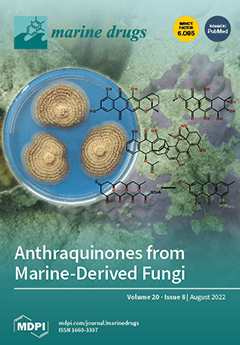Enantioseparation of the newly synthesized series of novel quinoline-2(1
H)-one epoxide structures
rac-
6a–
c and
rac-
8a–
c, named marinoepoxides, is described. Marinoepoxide
rac-
6a, the key intermediate in the total synthesis of natural
[...] Read more.
Enantioseparation of the newly synthesized series of novel quinoline-2(1
H)-one epoxide structures
rac-
6a–
c and
rac-
8a–
c, named marinoepoxides, is described. Marinoepoxide
rac-
6a, the key intermediate in the total synthesis of natural products marinoaziridines A and B, as well as their structural analogues, was synthesized by addition of the achiral ylide generated in situ from the sulfonium salt
5 or
7, to the carbon-oxygen double bond of the corresponding quinoline-2(1
H)-one-4-carbaldehyde
4a–
c in good yield. Separation of enantiomers of (±)-2,3,3-trisubstituted marinoepoxides
rac-
6a–
c and (±)-
trans-2,3-disubstituted marinoepoxides
rac-
8a–
c was studied using two immobilized polysaccharide type chiral stationary phases (CSPs);
tris-(3,5-dichlorophenylcarbamoyl)cellulose stationary phase (CHIRAL ART Cellulose-SC) and
tris-(3,5-dimethylphenylcarbamoyl)amylose stationary phase (CHIRAL ART Amylose-SA). Enantioseparation conditions were explored by high-performance liquid chromatography (HPLC) using dimethyl carbonate/alcohol mixtures and
n-hexane/ethanol (80/20,
v/
v) as mobile phase, and by supercritical fluid chromatography (SFC) using CO
2/alcohol mixtures as mobile phase. In all examined racemates, enantioseparation was successfully achieved, but its efficiency largely depended on the structure of chiral selector and type/composition of the mobile phase.
Full article






